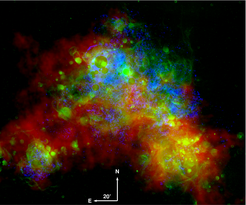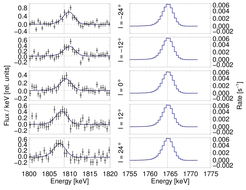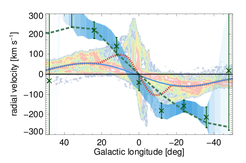Galaxy Structures and the ISM
The interstellar medium with its structure and dynamics plays a key role in galactic evolution, being the birthplace of stars. At MPE star formation and its interstellar conditions and signatures are studied by our colleagues in the infrared group, while the high-energy group studies the terminal stages of stellar evolution and their impacts on the hot, dynamic, and relativistic phases of the interstellar medium. Stellar outputs, their wind and explosion energies and their ejecta lead to bubbles and superbubbles up to 1 kpc in size, they thus shape the state and dynamics of interstellar gas. Magnetic field configurations follow from this and determine observable radiation such as, e.g., synchrotron emission. High energy astronomy provides more observational tools through emission from relativistic particles in the ISM, and from interstellar radioactivities, in addition to the thermal emission which still can be traced up to X-ray energies. Lessons from specific emission processes, and from source regions and its objects, are transferred to populations of sources or entire galaxies. This connects these nearby universe studies to surveys of the more distant universe and to models of stellar and galaxy evolution.
The interstellar medium in our and nearby galaxies can be studied at greater precision in a variety of tracers at different wavelengths, thus allowing in-depth studies of stellar feedback and evolutionary properties. XMM-Newton and Chandra observations show thermal X-ray emission from the hot ISM as it reflects shocks from explosions expanding into the ambient medium, and also hot interiors of superbubbles heated by the same. Radioactive decays from nucleosynthesis trace stellar outputs independent of gas density or thermodynamic state, and can be observed in gamma-rays, long-lived isotopes 26Al and 60Fe and positrons shining in INTEGRAL's energy window. In nearby galaxies such as in the Magellanic Clouds and M31 we can compose an outside view on a galaxy in sufficient detail to map both the interstellar gas and the various source populations influencing its state. Here we report about the interstellar medium in its hot and non-thermal phases, which are the objective of high-energy astrophysics studies hereto.
The hot interstellar medium
The hot ISM can be best studied in the soft X-ray band (0.2 – 2 keV) in nearby galaxies where survey observations can cover the total galaxy while resolving structures down to parsec scales. Diffuse X-ray emission in the Magellanic Clouds has been detected already by the Einstein Observatory and was further investigated by us using ROSAT. Between May 2009 and March 2010, we carried out an XMM-Newton survey of the Small Magellanic Cloud (SMC), which, together with archival observations, completely covered the bar and wing of the galaxy. Owing to the high sensitivity of the EPIC instruments the images which we obtained reveal the morphology of the diffuse X-ray emission in unprecedented detail. From a spatially resolved spectral analysis of the diffuse X-ray emission we obtained typical plasma temperatures of 0.2 keV (~2 Million Kelvin). The absorption by cold neutral gas along our line of sight strongly varies in the different regions of the SMC with a maximum in the south-west part of the galaxy. This is consistent with what we see from HI radio maps which indicate large amounts of neutral hydrogen in that region. The high X-ray absorption indicates that here the hot ISM is covered by neutral hydrogen in front of it. In contrast the diffuse X-ray emission from the north-east part of the SMC bar shows lower absorption, allowing a more direct view to it. This is nicely seen when comparing the emission from the hot ISM (soft X-rays) and from cooler gas (HI) as shown in the figure below. While in large parts of the SMC the hot ISM is still buried under cooler material, it shows features indicating outflows in other parts. Such outflows have been seen in soft X-rays from more distant galaxies with strong star forming activity like M82 and NGC 253. The latter was investigated by us with ROSAT and XMM-Newton.

The relativistic interstellar medium
The astrophysics of relativistic-particle processes in the interstellar medium has been pursued in the HE group over the past years, building on missions CGRO, INTEGRAL and Fermi-LAT, now reaching a wider significance for high-energy astrophysics. Our GALPROP project numerically models cosmic-ray propagation in the Galaxy and makes predictions of the electomagnetic radiation including hard X-rays, gamma rays and synchrotron radiation, as well as the cosmic-ray direct measurements. This includes realistic gas distributions from radio surveys, and interstellar radiation fields from a detailed radiation transfer code, using all available observables and theory to provide the best constraints on the properties of high-energy particles in the Galaxy. GALPROP involves MPE, Stanford, SLAC and other institutes, and has a wide user community, e.g. being the Fermi-LAT standard for Galactic diffuse emission and associated topics such as Fermi Bubbles. Highlights of this work from the past 6 years include: a unified model of the non-thermal emission from hard X-rays through gamma rays, as measured by INTEGRAL, CGRO-COMPTEL and Fermi-LAT. In particular the 100 keV X-rays were shown to be of inverse Compton origin from cosmic-ray electrons; the spectral energy distribution of the Galaxy as seen from an external observer, from radio to gamma rays (possible only with such a model), important for comparison with external galaxies; Fermi-LAT Galactic diffuse emission results; study of synchrotron emission related to cosmic-ray electrons and magnetic fields, including WMAP polarization and Planck survey data (see Strong et al. 2007).
The radioactive interstellar medium
Nucleosynthesis processes and their implications on the interstellar medium have been studied in the HE group of MPE, building on experience with the gamma-ray mission CGRO and now using measurements with SPI on INTEGRAL. These studies expanded towards a wider astrophysical scope through more interpretational and modeling studies and international collaborations with nucleosynthesis source experts (a.o. in the framework of the ESF's EuroGenesis program), and theorists simulating the interstellar medium (also in DFG's priority program on the ISM).

The superb spectral resolution of SPI (see figure on the left) has now allowed to trace large-scale Galactic rotation throughout the inner Galaxy, refining and deepening earlier hints. Surprisingly, the 26Al-carrying interstellar medium appears to be moving at much larger velocities than what we know from cold interstellar gas as seen in CO. The excess velocities of ~100 km s-1 have been modelled to be best explained if 26Al-ejecting massive-star groups are located on the leading edges of spiral arms, and thus blow-out of nucleosynthesis ejecta by winds and supernovae occurs with a preferred directionality between arms, so that an additional velocity component arises (Kretschmer et al., in prep.).

This has interesting implications for angular-momentum transport between the Galaxy's spiral-arm regions and the halo, and contributes to feed the Galaxy's central regions. In localized groups of massive stars, only the Cygnus region is a bright 26Al source, and is being studied in terms of how its massive-star groups shape cavities and possibly chimneys as winds and supernovae stir the interstellar medium (Voss et al. 2009...2012, Martin et al. 2009, 2010). The discrimination of 26Al emission in the foreground from the nearby Scorpius-Centaurus groups (Diehl et al. 2010) is now used to study propagating star formation evidence among those groups, combining infrared, radio, and gamma-ray data with the stellar census. Similarly, the nearby Orion region is a target of deep INTGERAL observations, in an attempt to measure ejecta blowout into the Eridanus cavity, which extends from the Orion OB1 association towards the Sun (Voss et al. 2010; Fierlinger et al. 2012).
A study of diffuse X-ray emission with XMM-Newton from the interior of the Eridanus cavity (Lubos 2012) could not improve upon earlier ROSAT findings, and dedicated observing strategies will be proposed to generate a suitable survey with XMM-Newton, for determination of hot-ISM temperature and homogeneity herein. Our simulations of massive-star feedback have shown us the importance of individual star and supernova cavities merging into superbubbles, and the significance of instabilities as the ejected gas cools. We found first evidence of the Vishniac instability in our 3D hydrodynamical simulations of the dynamic ISM. This instability gives, e.g., the Crab nebula is spectacular clumpy morphology in optical emission. This work has led us to a new model for the evolution of globular clusters, between the first-generation stars and gas losss towards their abnormal second-generation stellar population (Krause et al. 2013).
Authors: Roland Diehl, Frank Haberl
Selected MPE High Energy Group Publications in this area:
Ackermann et al. (Strong) 2012, ApJ 750, 1, 3; Diehl 2013, Rep.Progr.Phys. 76b, 6301; Diehl et al. 2011, Springer Lect.Not.Phys 812; Diehl et al. 2010, A&A 522, 51; Haberl et al. 2012, A&A 545, 128; Krause et al. 2013, A&A 550, 49; Krause et al. 2012, A&A 546, 5; Martin et al. 2012, A&A 543, 3; Martin et al. 2010, A&A 511, 86; Prantzos et al. (Diehl) 2011, Rev.Mod.Phys. 83, 1001; Strong et al. 2011, A&A 534, A54; Strong et al. 2010, ApJ 722, L58; Strong et al. 2007, Ann.Rev. Nucl Part. Sci. 57, 285; Sturm et al. 2013, A&A 558, 3; Voss et al. 2012, A&A 539, 66; Voss et al. 2010, A&A 520, 51; Voss et al. 2009, A&A 504, 531; Wang et al. 2009, A&A 496, 713; Wang et al. 2007, A&A 469, 1005; Weidenspointner et al. 2008, Nature 451, 159


